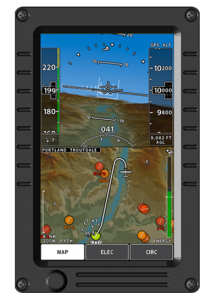Sit Back, Nvidia Tegra Can Land Your Plane
The Vertical Power VP-400 Runway Seeker does for planes what the car industry is trying to accomplish for cars: Take the pilot out of the equation and guide you safely to your destination without your interaction.
While there is much more to this device than just hardware, it is rather impressive what an ARM based processor is able to accomplish today. According to Nvidia, the Runway Seeker relies on a Colibri T20 Tegra module for all necessary calculations to take the plane on a path to the nearest airport and land it on a runway.
"As the plane flies, the Tegra calculates a glide path to every runway within range 30 times a second, taking into account factors such as wind speeds, runway lengths, terrain and potential obstacles," Nvidia wrote in a blog post. "For humans to estimate that in the middle of an emergency is very difficult to do, whereas it is relative easy and unemotional for a powerful microprocessor to do,” said Marc Ausman, co-founder of Vertical Power. There are plenty of other scenarios in which such a system could come in handy, especially for those pilots on rely on flying by sight.
Vertical Power said that the device also uses flight simulation software by X-Plane as well as a databases that describe airports, terrain, and any obstacles that could be encountered.
Contact Us for News Tips, Corrections and Feedback
Get Tom's Hardware's best news and in-depth reviews, straight to your inbox.

Wolfgang Gruener is an experienced professional in digital strategy and content, specializing in web strategy, content architecture, user experience, and applying AI in content operations within the insurtech industry. His previous roles include Director, Digital Strategy and Content Experience at American Eagle, Managing Editor at TG Daily, and contributing to publications like Tom's Guide and Tom's Hardware.
-
rantoc Even the simplest pocket calculator today have the computational power for this, just need the data to "crunch"Reply -
killerclick They should do this for cargo planes first, less consequences if something goes wrong.Reply -
NuclearShadow That is pretty cool but I think I would much rather prefer a human pilot despite this. With how airline workers are known to tend to strike I can only imagine how much push the airline companies will push to try to have it accepted by the FAA (and the other nations versions of such) to have them actually fly without a single human pilot.Reply
If you think I am being overly paranoid. The CEO of Ryanair wants to take not only seat belts out of planes but the seats themselves. The idea is you could herd and fit more people like cattle this way.
What to do in the case of turbulence to avoid injury he gives no suggestions. If a airline company would be willing to put people in that much risk for profits would it not make sense for them to save money by removing the pilot and co-pilot and have a computer that they would not have to pay to do the same job and remove the chance of a worker strike? -
scannall This is a solution looking for a problem. Commercial aircraft have had this ability for quite some time now. It is neat though, in that it is an example of just how far technology has come in a relatively short period of time.Reply -
ddpruitt Bleh.Reply
You take all of the spacecraft built up to and including the space shuttle and they had less computing power than an old Pentium, yet these things managed to land, navigate space, worked reliably for over 30 years. -
ddpruittBleh.You take all of the spacecraft built up to and including the space shuttle and they had less computing power than an old Pentium, yet these things managed to land, navigate space, worked reliably for over 30 years.Reply
I have a shovel that dates from before the Space Age, it still works, go figure!
-
Maxx_Power Humans > Machines. We have creativity in problem solving, not just computational power. Should a plane be in trouble, I would MUCH prefer the creativity of humans to find a solution, usually outside the box.Reply
Any one here watches "Mayday" ?
